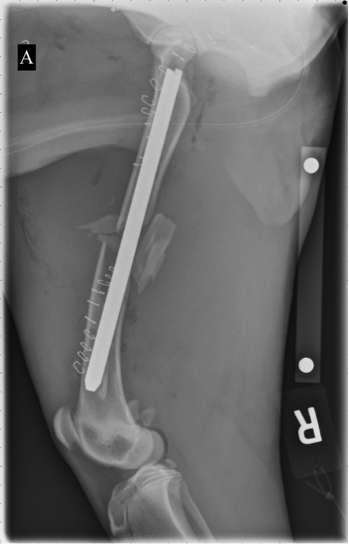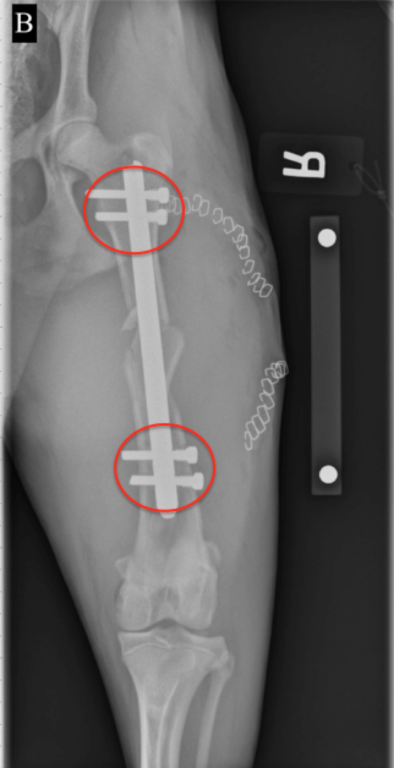Interlocking nail (ILN) fracture fixation is often considered the gold standard for the repair of many types of fracture configurations by human and veterinary surgeons. The procedure utilizes a large intramedullary rod through which interlocking bolts are placed distally and proximally on a long bone (Figures 1 & 2 ). It is typically used in humeral, femoral, and tibial fracture repair.

Figure 1: Lateral radiographs of a right comminuted femoral fracture in a dog repaired with an interlocking nail using minimally invasive techniques.

Figure 2. Ventrodorsal radiographs of a right comminuted femoral fracture in a dog repaired with an interlocking nail (red circles) and minimally invasive osteogenesis.
There are two main benefits of the ILN:
- Superior resistance to all forces acting on the bone (bending, torsion, shear, and axial forces) leading to improved healing and reduced complications. The biomechanics of the ILN are unique due to its placement within the neutral axis of the bone vs. the eccentric location as seen in bone plate fixation. Additionally, the area moment of inertia (AMI) is proportionality high for the ILN which provides greater resistance to bending forces thereby reducing the risk of repair failure compared to conventional bone plate repair. For example, studies have shown a 3.5mm limited contact plate and rod combination has an AMI of 26.01mm4compared to the AMI of an ILN of 200mm4.
The biomechanics of the ILN are unique due to its placement within the neutral axis of the bone vs. the eccentric location as seen in bone plate fixation. Additionally, the area moment of inertia (AMI) is proportionality high for the ILN which provides greater resistance to bending forces thereby reducing the risk of repair failure compared to conventional bone plate repair. For example, studies have shown a 3.5mm limited contact plate and rod combination has an AMI of 26.01mm4compared to the AMI of an ILN of 200mm4.
- It is amenable to minimally invasive placement techniques for fracture repair thereby leaving the fracture site undisturbed. Minimally invasive osteosynthesis (MIO) is a biological approach to fracture fixation which avoids approaching the fracture site. The goal in utilizing ILN fracture fixation along with MIO is to preserve the fracture hematoma, improve healing, decrease post-operative pain, and decrease overall complication’s leading to a quick recovery, more comfortable patient, and satisfied clients.
Success rates of the INL in dogs and cats have been reported from 83-96% for fracture repair. However, correct placement of the distal bolt can be challenging. Incorrect placement has been reported in up to 28% of cases which may lead to rotational instability and fracture failure. The ILN is available in a variety of diameters and lengths, which better serves a wide variety of canine and feline patients.
References:
Johnson SA, Dirsko JF, Dejardin LM, Weh M, Roe S. In: Tobias KM, Johnston SA, eds. Veterinary Surgery: Small Animal. St Louis: Elseveir, 2012; 576-607.
Chao, P, Lewis DD, Kowaleski MP, Pozzi A. Biomechanical Concepts Applicable to Minimally Invasive Fracture Repair in Small Animals. Vet Clin Small Anim42 (2012) 853-872.
Dejardin LM, Guiot LP, Dirsko JF. Interlocking Nails and Minimally Invasive Osteosynthesis. Vet Clin Small Anim 42 (2012) 935-962.
Dejardin LM, Guillou RP et al. Effect of Bending Direction on the Mechanical Behaviour of Interlocking Nail Systems. Vet Comp Orthop Traumatol 4/2009

